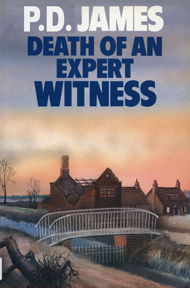 Just finished Death of an Expert Witness by P. D. James. This is the sixth of 14 Adam Dalgliesh novels written by the highly honored British mystery writer. Here Dalgliesh is called to investigate the murder of Dr. Lorrimer, the “Chief Science Officer of the Biology Department” at a forensic laboratory.
Just finished Death of an Expert Witness by P. D. James. This is the sixth of 14 Adam Dalgliesh novels written by the highly honored British mystery writer. Here Dalgliesh is called to investigate the murder of Dr. Lorrimer, the “Chief Science Officer of the Biology Department” at a forensic laboratory.
While not exactly a “locked room mystery,” there are some of the elements: the victim is found when the stand-alone laboratory building is unlocked and opened with one of the four sets of keys existing. How did the murderer get in and out without access to one of the keys? So the investigation centers on the people that work there in one capacity or another, and gradually many ties to the victim are revealed. At the same time, we learn that despite Dr. Lorrimer’s obvious expertise with blood work and hair samples, he is very much disliked by the majority of his colleagues for a variety of reasons. The question is, which tie and which reason will lead to the murdering colleague?
As with other James novels, the theme of human nature is explored: jealousy, lust, passion, resentment, pettiness, impatience, greed – they are all things that both Dalgliesh and the narrator reflect upon. All that mixed with religious tones – a second murder takes place in a small chapel, and intelligent reflection. By the end, we don’t find it odd that even the murderer joins in self-reflection:
“A murderer sets himself aside from the whole of humanity for ever. It’s a kind of death. I’m like a dying man now, the problems are still there, but I’m moving away from them into a new dimension.”
Compared to the other two Dalgliesh books I’ve read (A Certain Justice –the best of the three– and The Private Patient), Dalgleish is reflective but there is little to find interesting or attractive. He expresses horror at some of his own emotions and desires, but never reveals this to his subordinate or to anyone else. We learn nothing about his life outside of The Yard or his past. Of course, none of the characters (mostly all suspects with major flaws) are especially likable either. So I was not drawn to the book as with other mysteries where I can either identify with or at least enjoy something about the lead character.

I’m Not Fond Of Puzzles with Hundreds of Little Pieces
The book is like a giant puzzle with hundreds of little pieces of evidence. And I mean little. Who sat next to who at a concert, a fact dropped by a witness but never highlighted by the investigators or the narrator until the end (the solution). There are many teensy items like that, shuffled into the pages of the book.
Perhaps the puzzle analogy is lacking, because in reality only a half dozen facts are needed to point to the murderer. So it is more like sifting through the hundreds of puzzle pieces to find the small handful that are actually used to make a puzzle; the rest being thrown out as unrelated.
I know, I know: that’s what real detectives do – sift through the evidence. But I get the feeling that James makes it intentionally difficult by hiding the clues much like a parent hides Easter eggs and can’t wait to show the child where they were hid when they give up.
In my other life as a trainer of technical trainers, I have often remarked about the trainer of the equipment troubleshooting course who “puts a problem into the machine” for students to practice using their documentation and their reasoning to find the fault. I tell about the instructor I once heard laughingly gloat, “I’ll put in a fault that they’ll NEVER find!”
And sure enough, in Part 4, Chapter 8 we listen as Detective-Inspector Massingham talks with Dalgleish, his boss, about what they just learned from their latest interview:
‘We haven’t done too badly out of their encounter. We know now who killed Lorrimer.’
Dalgleish said: ‘We think we know who and how. We may even think we know why. But we haven’t a scintilla of proof and without evidence we can’t move another step.’
Really? I don’t know whether at that point they really knew who the murderer was or not as they don’t say. Frankly, it feels like James is taunting the reader, and it’s not fun!
When the book was over, and I finally knew who the actual murderer was, I went back through the book trying to see where the half dozen clues that Dalgliesh mentions at the end were revealed to the reader along the way. I did in fact find them, but like I said, it seemed like the author went out of her way to tear each separate clue into little pieces and scatter it among several paragraphs all through the book. As is often said about mystery book rules, “Did the author play fair?”
I felt like the introduction of characters and setting in Part 1 of the book was also deliberately confusing. Lest I sound like a whiner, here’s a couple examples:
1) In chapter 1 there are several references to Nell, daughter of Kerrison. Chapter 2 begins with a focus on Eleanor Kerrison. Are they the same? I guess. But couldn’t it be made more obvious? James uses this trick a few more times where in one chapter a woman is called “Dom” and in another chapter by her full name, “Domenica.” Why not make it clear the first time the name comes up?
2) The scene is the Hoggatt’s Forensic Science Center, one of a number of regional crime labs established across the country. But James doesn’t introduce it that way. Rather references are made to “Hoggatt’s” in one chapter and “laboratory scientists” in another chapter; presumably it is the reader’s job to piece basic names and places together.
In using the grading form, I felt I had no choice to give James a nine out of ten for #9 “Writing style was mature, flowed well.” But her style also annoyed me.
So I took advantage of the rarely used item #11 to deduct 3 points with this remark: James’ writing style may have been “mature” but it was also tedious, unnecessarily descriptive, and seemingly used to deliberately clutter the verbal landscape to hide the clues.
My final score for Death By An Expert Witness was 70.5.
The average score using all eleven Mystery Book Fans participating was: 76



We were close again, Dick. I gave this story a 72–much lower than other PD James stories. But on the WRITING, I gave the story high marks. Here are some examples–the first two were very perceptive remarks about crime. First, Dalgliesh asks of the victim “What was he like? The victim was central to the mystery of his own death.” There we see starkly the question of MOTIVE. Second, again of Dalgliesh: “he had become adept at reading the stigmata of violence.” That is, the corpus delecti tells the story of the murder.
Next, is simply a matter of really beautiful writing. So, Dalgliesh is in the country and experiences this: ” …a sound he had never heard in the noise of cities, the first, gentle sibilant whispers of the night rain. Soon, it was followed by a splatter of drops against the window and the rising moan of the wind in the chimney.” PD James is definitely one of those mystery writers who blur the line betwen the genre of the mystery and literature itself. Love it!